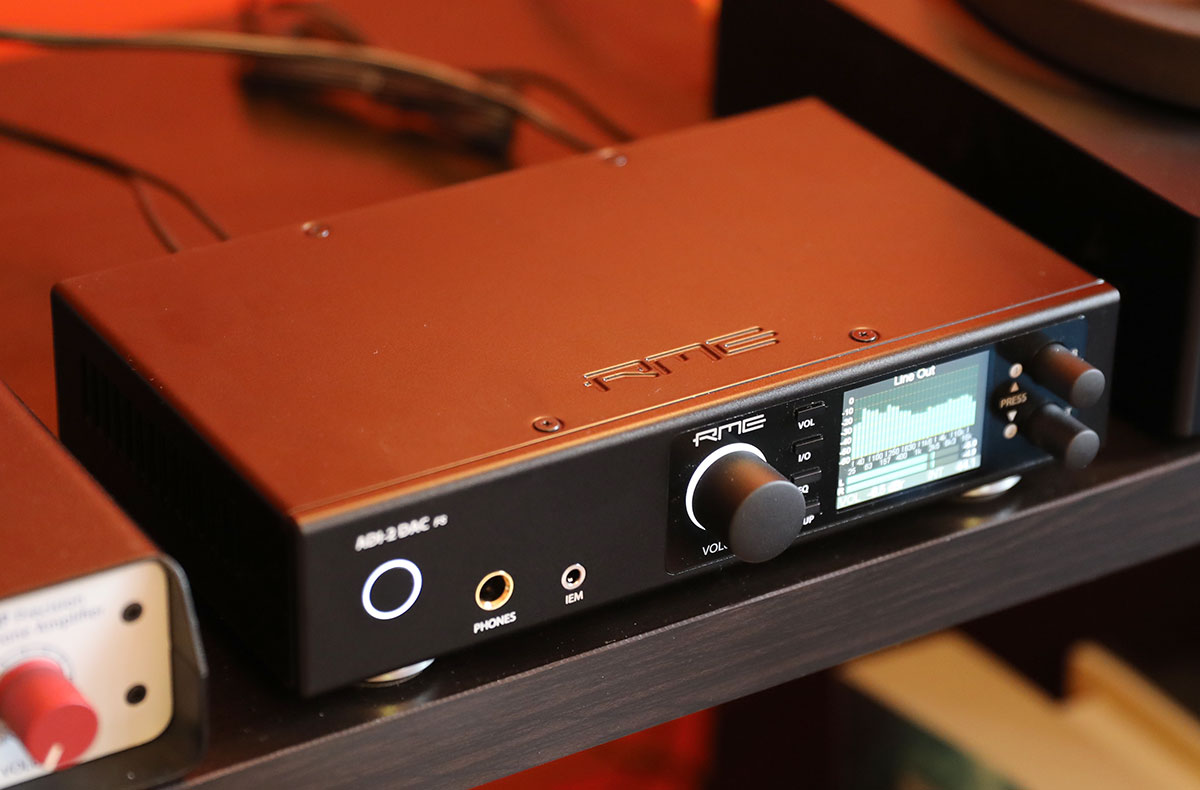
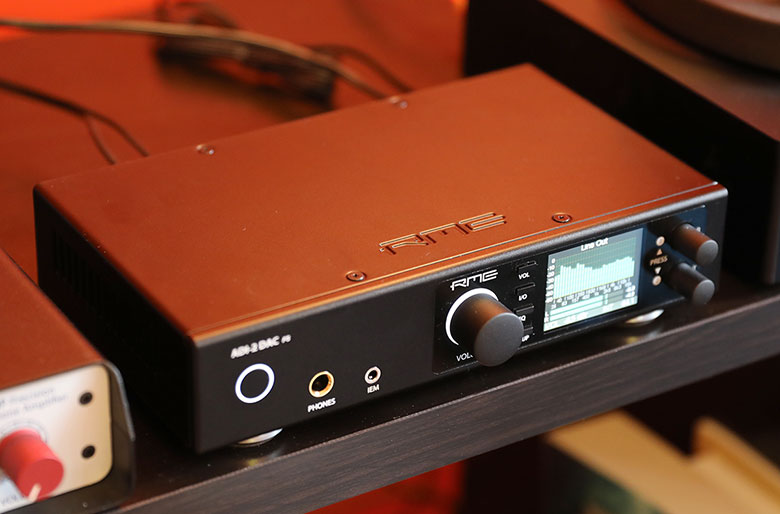
The Master Switch


The Master Switch
Amp: Yes
Chip: AK4490EQ
Max Sample Rate: 32-bit/768kHz
What We Like: Ridiculous sound quality, great screen, unbelievable value.
What We Don’t: One heck of a learning curve.
See the RME ADI-2 DAC
RME have been quietly making nerdy audio equipment since 1996. The German manufacturer might not be a household name stateside, but they've become very good at what they do. We were able to spend a month with their ADI-2 digital-to-analog converter, and are convinced that even the most popular US audio companies should be worried. Very worried. In this review, we break down the ADI-2 DAC's sound, design, packaging and accessories, specs and more. To see how it stacks up, check out our list of the best DACs.
The RME ADI-2 DAC has a ton of great features, and we'll get to them shortly, but we'd like to start with the sound quality. We'll put this as simply as we can: the ADI-2 DAC is one of the best-sounding pieces of audio equipment we've ever heard. Not just one of the best DACs; one of the best anything, period.
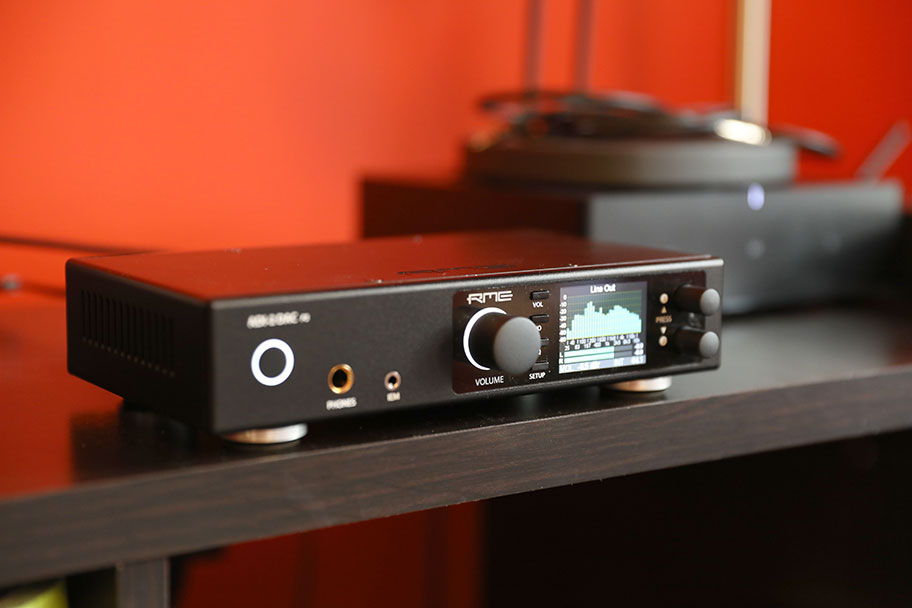
Digital-to-Analog Converters (DACs) are all about noise and timing. The goal is to convert digital ones and zeros into an audible electrical signal, and do so in such a way that the timing of the recording is preserved perfectly with as little noise as possible. The more successful a DAC is at doing so, the better the resulting sound quality will be. For example, the DAC chip in your standard smartphone is not good at this, whereas the DAC chip in the ADI-2 DAC is absolutely breathtaking. Even before you start fiddling with equalization (EQ) and loudness, and all the other myriad of things it can do, the ADI-2 DAC will have already taken over your life. Even if all you do is set it up, plug-in some headphones, and start listening, you'll be blown away.
We are talking absolutely astonishing clarity. Every single element of every song we listened to felt as precise and machined as a freshly-cut diamond, with incredible realism. And not the stark, almost brutal realism of something like the Benchmark DAC3 HGC (full review here), which costs almost $1,000 more than the ADI-2 DAC. The ADI-2 DAC's sound felt natural and genuine; nothing was forced or out of place, and to our ears, super-precise. And noise? Get outta here. It was, as far as we could tell, close to zero. Even with the most sensitive in-ear monitors we could find, the background was as sweet and black as Vietnamese coffee. This DAC elevated every piece of equipment connected to it, from amp to headphones, sharpening the detail and polishing it beautifully.
The ADI-2 DAC supports audio files up to 768kHz. This kind of performance would be impressive at any price point. For the $1,299 price of the ADI-2 DAC, it's ridiculous. You have to trust us on this; we know our DACs. We test a dozen or so each year, often more. We've sat down and played with the Chord Electronics Hugo 2 (full review here), which we consider to be the best overall DAC currently available. And right now, we're testing a Mytek Brooklyn Bridge, which is a streaming version of their famous Brooklyn DAC+. Even in comparison to these monsters, for under $3,000, we don't think we've found a DAC that impressed us as much as the ADI-2 DAC. It's quite extraordinary.
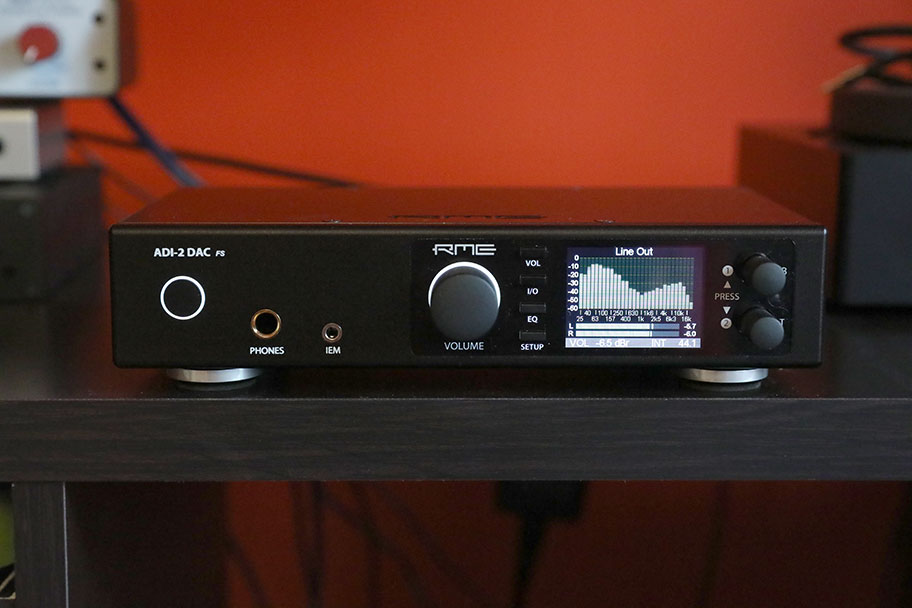
There's a lot of smoke and mirrors in the audio world. Companies repackage old equipment in new housing and sell it for a premium. Cable manufacturers charge thousands and thousands of dollars for products that have only the mildest, most subtle effect on the sound. With the ADI-2 DAC, there's no smoke, and the only mirror it holds up is one that reflects how well a song was recorded. Despite our affection for it, the ADI-2 DAC definitely has its faults. One of our main qualms is that there's no Bluetooth connection of any kind, which is something found in several other DACs - including the aforementioned Chord Electronics Hugo 2. That's a bit of a sticking point, in our opinion, and knocks the ADI-2 DAC down a couple pegs on our list. All the same, we can't judge RME too harshly for this, because the sound is so spectacular that it's worth the extra aggravation of wires.
And yes, if you put it head-to-head against something like a Chord Electronics DAVE, then it will probably come off second best. We wouldn't know, because we haven't been able to bribe Chord to send us a DAVE for in-office testing. But in the sub-$3,000 category, there's simply nothing that sounds quite as good. The fact that the ADI-2 DAC is nudging the lower end of that price range is simply staggering, especially when we haven't even gotten to the best part - the features…
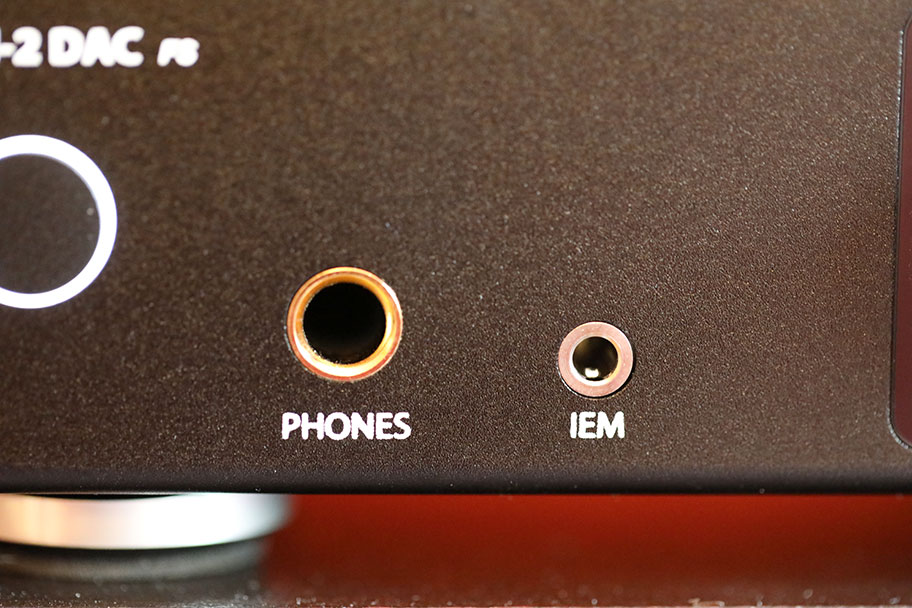
The RME ADI-2 DAC isn't just a DAC. It's also a headphone amplifier, and has a couple of additional elements worth examining. The first is that it claims it can drive any headphone or in-ear monitor, no matter how large the impedance. That's quite a claim, but fortunately for RME, the ADI-2 DAC is more than capable of putting its money where its mouth is. Not only does it offer separate outputs for both in-ear and full-size headphones, but incorporates a setting known as Extreme Power. And when a European company starts using adjectives like extreme, you know you're onto something interesting.
What we really wanted to do was track down a pair of HiFiMAN HE-6 headphones for testing – we seem to remember them coming with instructions for building a dedicated power plant in your backyard. Try as we might, a pair eluded us. Fortunately, we had plenty of highly demanding headphones available, including the more common Beyerdynamic DT 880s, which have an eyebrow-raising impedance of 600 ohms. Regardless of which headphones we used or how demanding they were, the ADI-2 DAC handled them with ease. Whether on Extreme Power or regular everyday power, we never had any issue getting a decent level of volume.
The in-ear monitor output impressed us, too. We plugged in the Campfire Audio Andromeda - a pricey pair of earbuds that have both an exquisite green housing and exquisite sensitivity (115dB). If you plug those into a less refined DAC or headphone amp, you'll experience a lots of noise, including hiss, hum, and occasional pops as the amp's flaws are revealed. But that wasn't the case with the ADI-2 DAC. All was calm and clear.
The headphone outputs of the ADI-2 DAC incorporate a couple of other clever features, too. They are able to detect when a pair of headphones is connected, meaning that this DAC is able to automatically switch the output. And if you play music, it doesn't automatically start playing at your set volume. Instead, it slowly raises over the course of a second or two, giving you time to yank your headphones off if you've mistakenly left Extreme Power activated. It's all exceptionally useful, and the kind of features we wouldn't expect to see in a sub-$1,500 DAC.
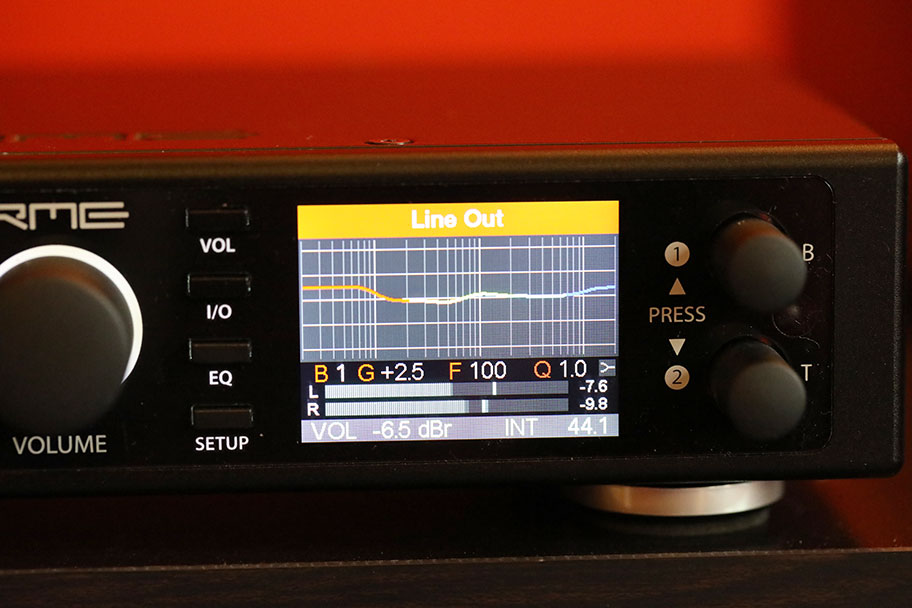
If for some reason you aren't satisfied with the base sound of the ADI-2 DAC, RME have incorporated an EQ for you to play with. It's a five-band EQ, and allows you to raise or lower the bass, treble, and mids as you like. It's all accessible via the screen on the front of the DAC. We'll talk about this screen in much more detail below, but for the most part, the EQ works well. Again, it's not something we can recall seeing in any other DAC in this price range; we certainly didn't see one in the Schiit Yggdrasil. That DAC costs significantly more than the ADI-2 DAC – and in all honesty, we prefer the ADI-2 DAC. Schiit may be cooler than RME in a number of ways (you have to have serious cojones to name your company Schiit Audio) but they've lost a few places here.
Ultimately, we didn't end up using the EQ much. It's surprisingly subtle, and while it does work well, we found that we were satisfied enough with the raw sound quality. If you do decide to make use of the EQ, however, you'll find it's both intuitive and satisfying. You can also store up to twenty different presets, making it easy to dial in settings for different genres.
There's also a very clever feature that RME simply call Loudness. Their thinking goes as follows: at low volumes, music tends to sound worse than it does at high volumes. This is thanks to the way we hear different frequencies at different volumes, and it can be a frustrating problem if you listen to music on low. But if you turn the ADI-2 DAC's Loudness feature on, then drop the volume, the bass and treble gain go up by about 7dB (and you can change this number if you want). It means that even at low volumes, music loses very little of its luster. We tested this using a pair of MEZE 99 Classics (full review here). The Classics are a pair of headphones that, while excellent, tend to sound a bit lifeless at low volumes - they're a TMS favorite, the kind of headphones we'd save if the office caught fire, but they aren't perfect. The ADI-2 DAC didn't completely eliminate the problem, but it made a real difference.
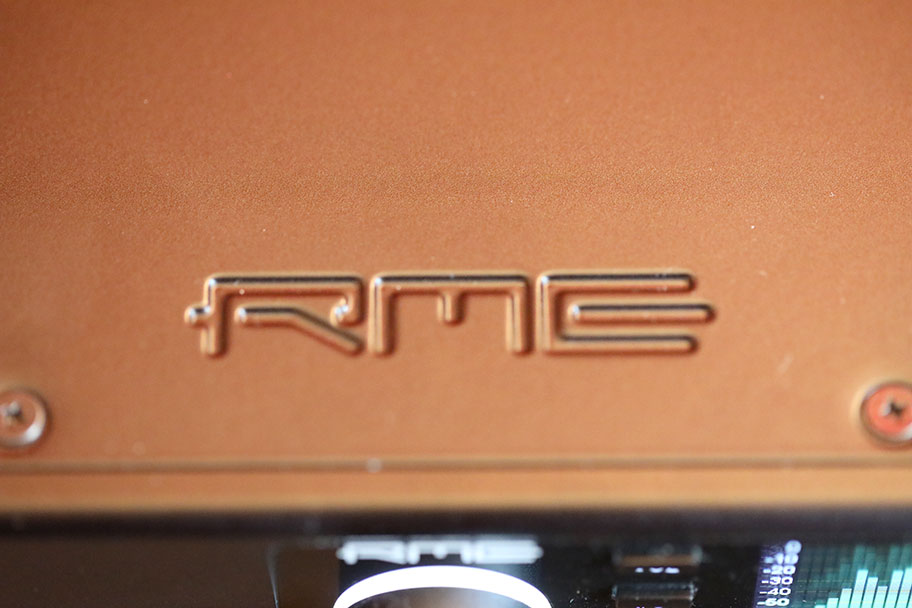
RME definitely know their audience. The kind of person most likely to drop $1,000-plus on a DAC is also the kind of person most likely to have experimented with DSD audio – ultra-high-quality audio files that you can read more about here. If you connect the ADI-2 DAC to a source playing DSD (up to DSD256), it automatically senses the file and adjusts its settings accordingly. Any Digital Signal Processing (DSP) settings - in other words, settings that affect the sound before it's converted into analog audio - are deactivated. That means no EQ or Loudness features. In addition, if you happen to use DSD Direct mode (which plays DSD audio without converting it to regular PCM, or Pulse Code Modulation, which is the type of encoding for just about every piece of music you've ever heard), then it will disable the volume control as well. In our opinion, it's intelligent programming, and works well, even if it doesn't change the fact that finding decent albums in DSD is a different struggle.
Additionally to all its great features, the ADI-2 DAC can also be used as a recording device, and specifically as a device for recording DSD audio. It's designed to be just as comfortable in a professional studio as it is on a listening rack. This is not something we actually tested – at TMS, we're all about the listening. We can't imagine that there would be any significant issue here, but let us know if you've tested it yourself!

If you're using the RME ADI-2 DAC with an Apple or Windows machine - as opposed to a mobile device, which is also possible - then you can download a special piece of software called DIGICheck. It's not overly useful in the grand scheme of things, but presents a number of ways of visualising the audio output, such as spectral analysis, global levels, bit statistics and global noise. It's great if you want extra detail, but you certainly don't need it to use the DAC. We'll admit, we used the DAC for two weeks before even noticing this feature.
And that's kind of how it is with the ADI-2 DAC. It can do so much, and has such an enormous range of features, that it's entirely possible we've left out something crucially important here. We are not even halfway through this review, and it's already significantly longer than most other reviews on this website, simply because there is so much to take in. We say again: for under $1,500, the value here is absolutely staggering.
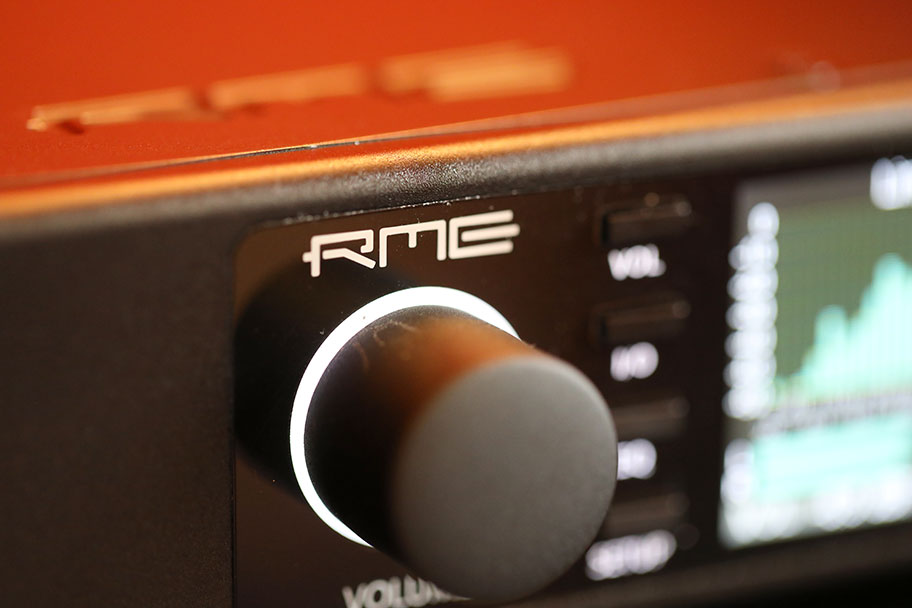
Enough about the sound. If we keep talking about it, we'll be here all day. Instead, let's zoom out a little, and take a look at the ADI-2 DAC's form factor. From a distance, it doesn't look like much: another entry in the endless parade of black boxes that characterise most hi-fi equipment. But step a little closer, and you'll see some rather interesting touches.
While the casing may be a black box, it's a robust black box made of cold, reassuring metal. The power indicator is either red (on) or white (off), and the light is always on – if we're being honest, it's actually a bit bright, meaning you don't want to have this in your bedroom. There's a ring around the volume knob that lights up, too. It's certainly more restrained than the technicolor wonderland of the Chord Electronics Hugo 2, but at least it has some significant personality. We also love the metal feet, which do their job while subtly adding some silver highlights into the mix.
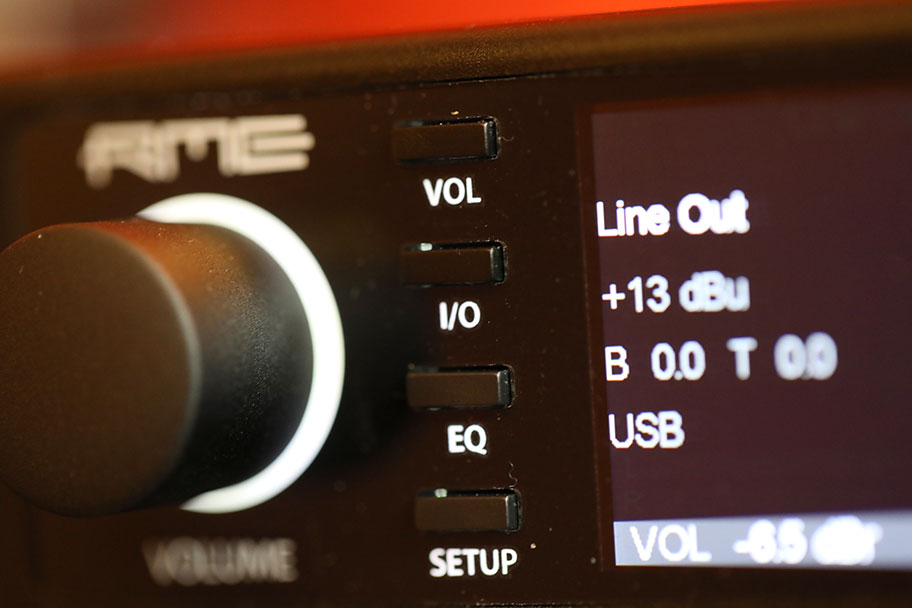
Now for the screen. It's the single most eye-catching feature on the ADI-2 DAC, and outside of the incredible sound, it's the one thing that separates it from other DACs. It's the ADI-2 DAC's most compelling feature, yet also its biggest weakness. It's a fascinating example of what you can do with a little technical ingenuity…and a potent lesson about why you should maybe question your motives first.
Here's what we mean. The screen is a gorgeous 2" by 1", full-color, bright box that displays a wealth of information about the audio. Its main screen is the State Overview, which displays a bouncy, real-time frequency graph and level meters showing volume and which frequencies are playing. It's geeky as hell and incredibly cool. There's something satisfying about seeing this thing kick off while listening to music. At its best, the screen more than justifies the cost of the DAC, and gave us another reason to love it.
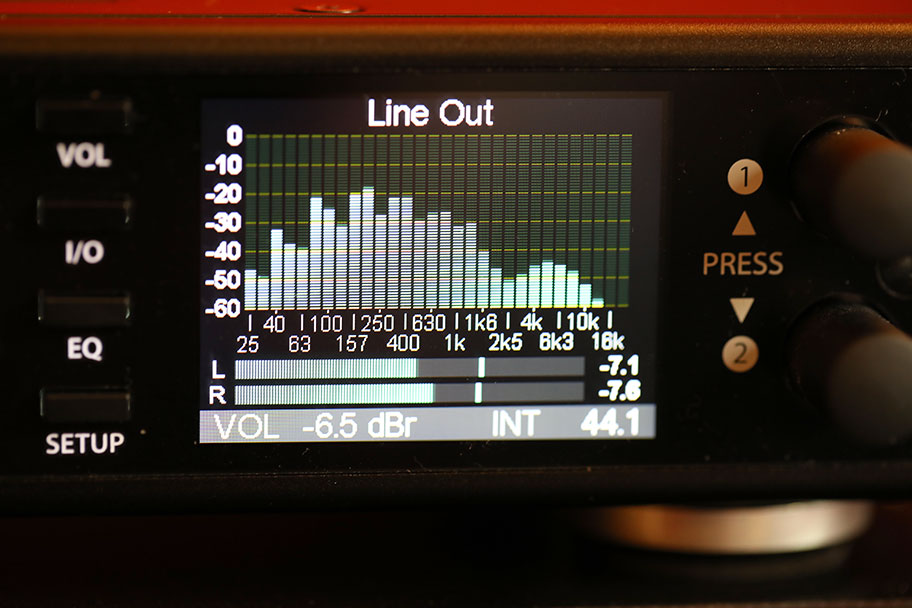
The screen is also where you'll adjust all the settings of the ADI-2 DAC, and this is where things get complicated. You see, this isn't a touchscreen. To adjust anything on it, you have to use the controls that surround it. Not since the stupendously complicated Benchmark DAC3 HGC, whose designers thought that a combination of tiny lights was the best way to communicate settings, have we struggled this much with a menu system. It doesn't have a learning curve so much as it has a learning loop-de-loop.
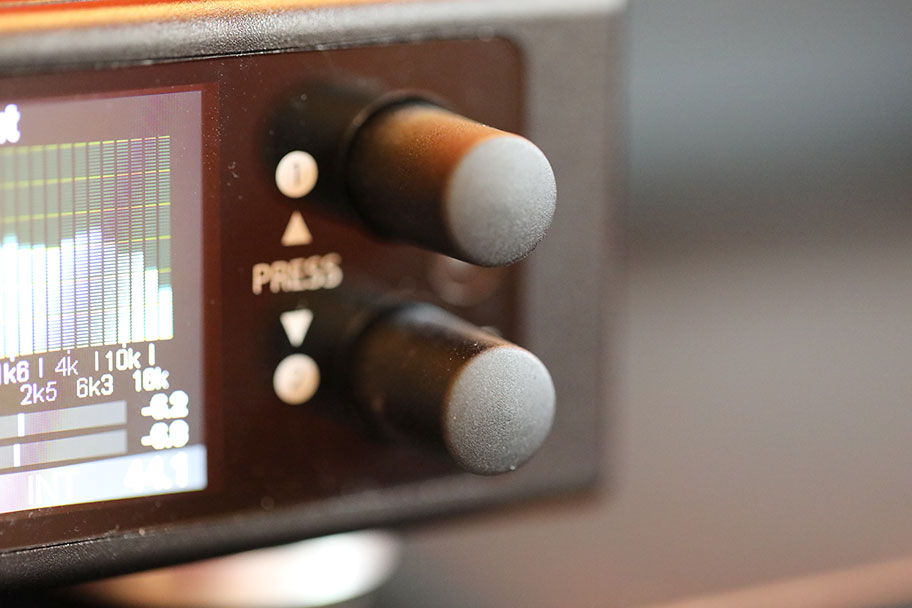
To navigate your way through the admittedly well-laid-out menus, you will be using no less than four different buttons and three context-sensitive rotaries - the volume knob and two smaller knobs – all of which can also be pressed. It is almost impossible to navigate the settings of this DAC without finding a dead-end, turning on Extreme Power, or generally screwing things up to the point where a factory reset is required. Again: the actual menus themselves are straightforward, and the manual that comes with the DAC is comprehensive and easy to navigate. But if you want to get the best out of your ADI-2 DAC, you'll have to spend some time with it. You'll have to sit down, learn how it works, and read the damn manual. Believe us, there's no way round this.
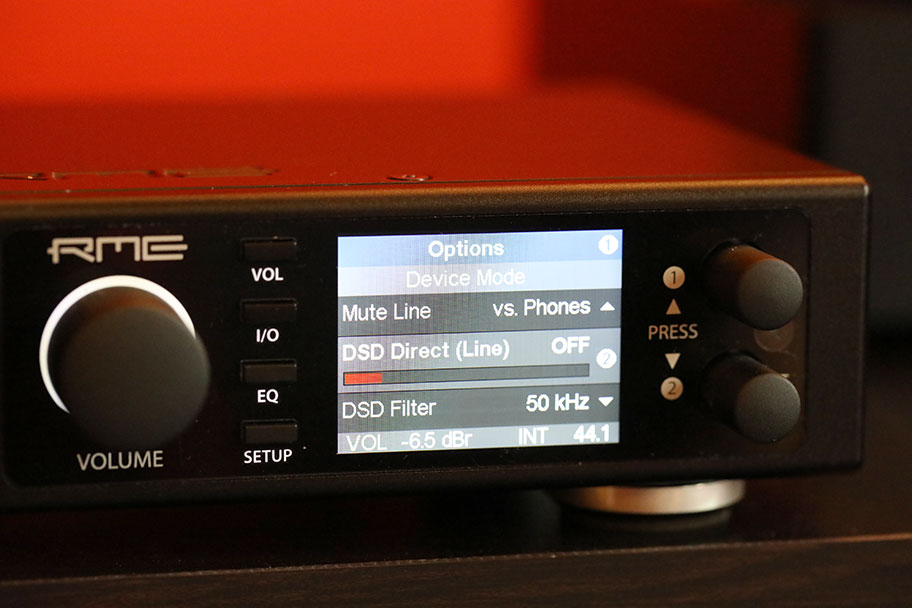
This is the main problem we had with the ADI-2 DAC. While we have no issue with getting to grips with a tricky piece of equipment, we do have an issue with processes that are far more complicated than they need to be. All that time spent devising the DIGICheck software could have been put to use designing a mobile app, which would have handled all the myriad settings for the ADI-2 DAC in a much more user-friendly way. With these situations, we always think of our favorite example, the SVS PB16-Ultra (full review here). That subwoofer, which goes for about $2,500, had a simple physical display matched with an absolutely gorgeous app that let you tweak just about any aspect of the system. Why couldn't we have had something similar here? It's not that we don't like the screen, we just don't like navigating it. The RME ADI-2 DAC is a remarkable piece of engineering, with sound that we are going to be dreaming about long after we send our review unit back. But right now, the menu system feels like it was designed by engineers for engineers. In our book, that's not a good thing.
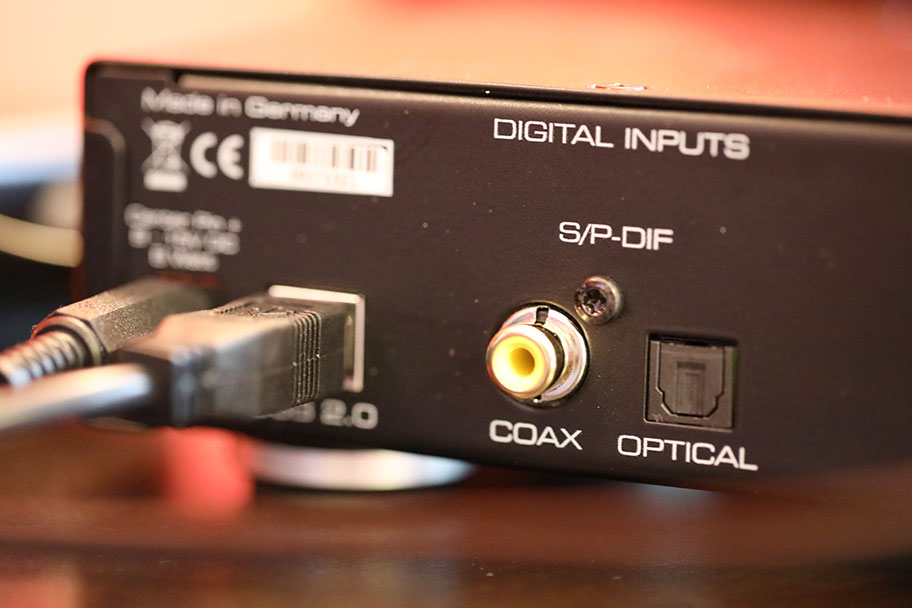
Aside from the two headphone outputs on the front of the ADI-2 DAC, you get a line output around the back, as well as two balanced XLR outputs (read more about what these are here). The input section is comprehensive, too. In addition to the standard USB input, there's a coax input and an optical connection. As we already mentioned, we would have loved Bluetooth connectivity - 5.0, aptX and LDAC all offer excellent sound quality that we felt were missing from the package. To our knowledge, there are no products from RME that actually offer Bluetooth functionality, which is kind of a shame. However, we have no beef with the physical inputs and outputs of the ADI-2 DAC, all of which work well and set you up for just about any situation.
In the short time it’s been available, the ADI-2 DAC has become a huge favorite in the headphone world. You can’t wander around a message board without tripping over photos of ADI-2s. However, RME certainly haven’t rested on their laurels. They recently released an update to the ADI-2 DAC. It’s not a new model, and it has the same name, but it replaces the old one in stores – and boasts some genuinely great updates, without a price rise.
One change is in the DAC chip, which moves from an AK4490 to AK4493. While the sound isn’t dramatically altered, it’s become a little cleaner, with a slightly altered signal-to-noise ratio (more on what this is here) and less distortion. RME have also lowered the noise floor on the headphone outputs, which means that sensitive in-ears have even less hiss, even at high volumes. RME have also upgraded the remote. It was pretty good to begin with – more on this below – but it’s been given a complete redesign. It gives you direct access to the EQ and crossfeed settings, without having to dive into those interminable menus.
What really gets us is that RME did this with virtually no fanfare at all. Quietly, consistently, they’ve been working to improve their products, and making almost no noise about it. We can think of several companies off the top of our heads that would have trumpeted this with a thousand annoying press releases. RME? They just made things better. They are not asking listeners to pony up another few thousand dollars for a slightly upgraded model – this is simply improving the one that is currently on the market. If you already own an existing ADI-2 DAC, then you probably don’t need to upgrade. If you’re thinking of buying one, then you’re getting even more value for money, on a DAC that was already huge in terms of bang for buck. Frankly, we wish more companies did this, and it reinforces our conviction that this is one of the best DACs on the market right now. Just go buy the damn thing.
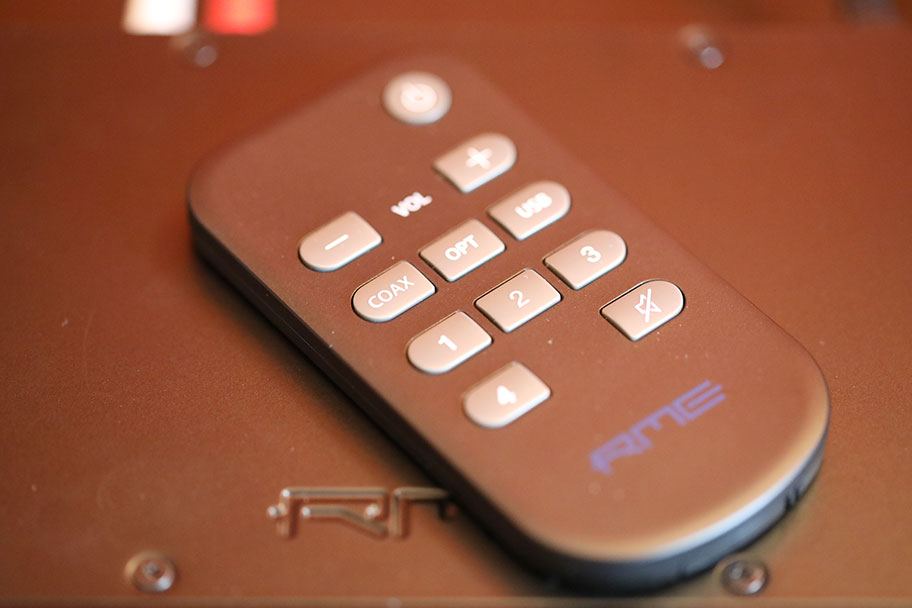
Outside of the standard selection of power and USB cables, the main accessory included with the ADI-2 DAC is a surprisingly competent remote. DAC remotes tend to be an afterthought – the one that comes with the Mytek Brooklyn DAC+ is literally an Apple Remote, thrown in like a bonus – but this one works well. It's not overly complicated, allowing you to select your input, change the volume, mute the audio, and choose from various presets. These are sensibly set up to showcase some of the ADI-2 DAC's settings, but you can change them to whatever you prefer. If you have various EQ presets, for example, you can select them with the push of a button.
One slight surprise we found with this DAC was the fact that the packaging is one of the more sizeable boxes we've seen. We can't really think of a good reason for this, but it makes for an interesting unboxing experience. Maybe RME could be a bit more earth-conscious in the future...
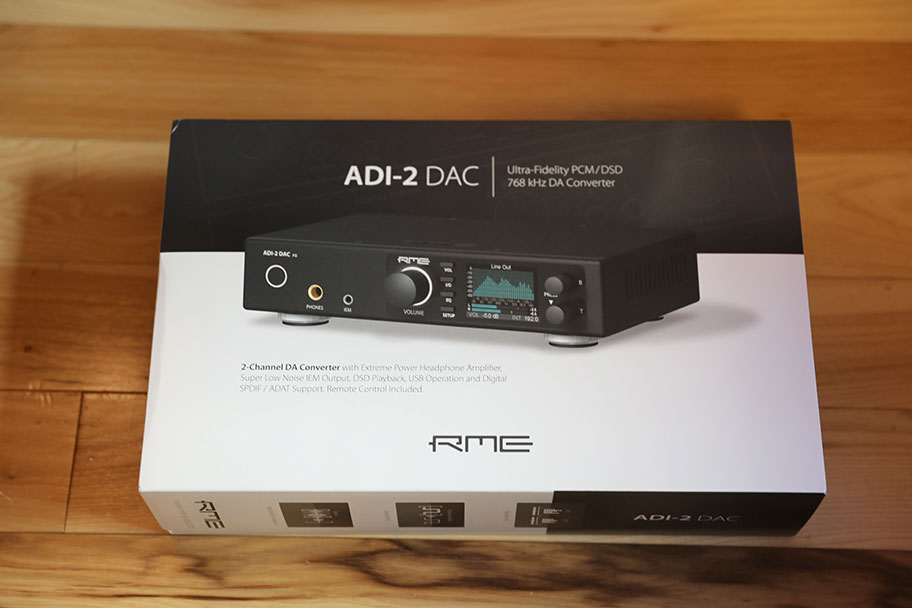
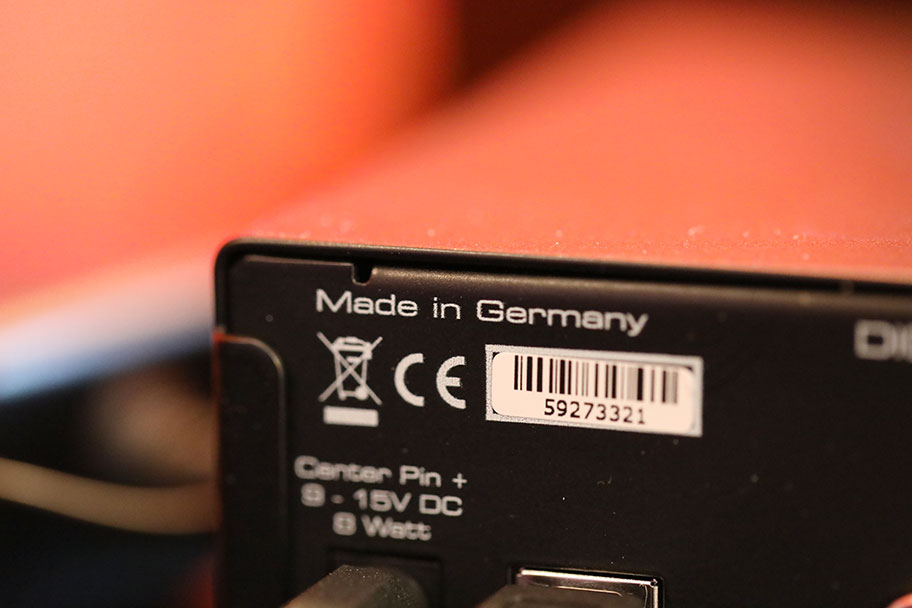
| DAC | Price | Amp | Chip | DSD? | Max Sampling |
|---|---|---|---|---|---|
| RME ADI-2 DAC | $1,299 | Yes | AK4490EQ | Yes | 32-bit/768kHz |
| Chord Electronics Hugo 2 | $2,695 | Yes | Xilinx Artix 7 | Yes | 32-bit/768kHz |
| Benchmark DAC3 HGC | $2,195 | Yes | ESS 9028PRO | Yes | 32-bit/192kHz |
| Mytek Brooklyn DAC+ | $2,195 | Yes | Sabre 9028 Pro | Yes | 32-bit/384kHz |
| RME ADI-2 Pro FS | $1,999 | Yes | AK4490EQ | Yes | 32-bit/768kHz |
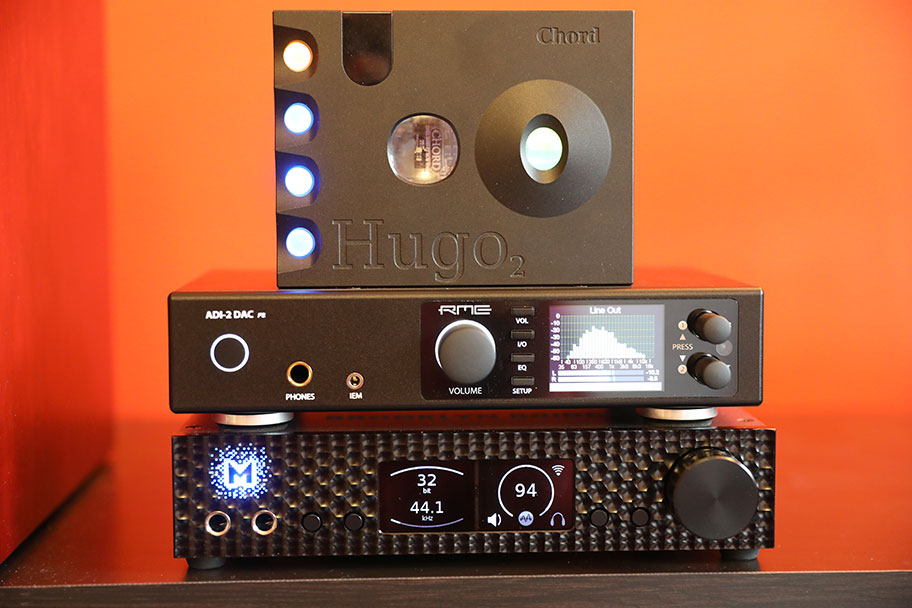
One of the first comparisons that sprang to mind while using the RME ADI-2 DAC was the Benchmark DAC3 HGC. This $2,195 DAC is a bit old now, but has a similar sound profile to the ADI-2 DAC. The audio quality is tremendous, with a deep sense of neutrality and balance. The problem? Not only is it much more expensive, but it's menu system and navigation are even more complicated than the ADI-2 DAC's. There's no screen – just a series of lights that you have to interpret - making the change of settings an exercise in frustration. We loved our time with this DAC, and we still think it's a phenomenal option, but in a straight head-to-head battle, the cheaper ADI-2 DAC wins easily. It offers slightly better sound, and a much better overall experience.
Another competitor is the Chord Electronics Hugo 2. This is our everyday go-to DAC and with good reason. It has one of the funkiest, most enjoyable interfaces we've ever come across. Like the Benchmark DAC, it communicates with a series of coloured lights, but these are much easier to interpret, and it makes for a DAC that's as easy on the eyes as it is on the ears. This may be a bit of a heresy, but we think the RME ADI-2 DAC actually sounds better than the Hugo 2. While the latter is great, the ADI-2 DAC is a little more natural. The Hugo 2 is also far more expensive, at $2,695. However, it does have Bluetooth, meaning that it has a portability that the ADI-2 DAC most certainly does not.
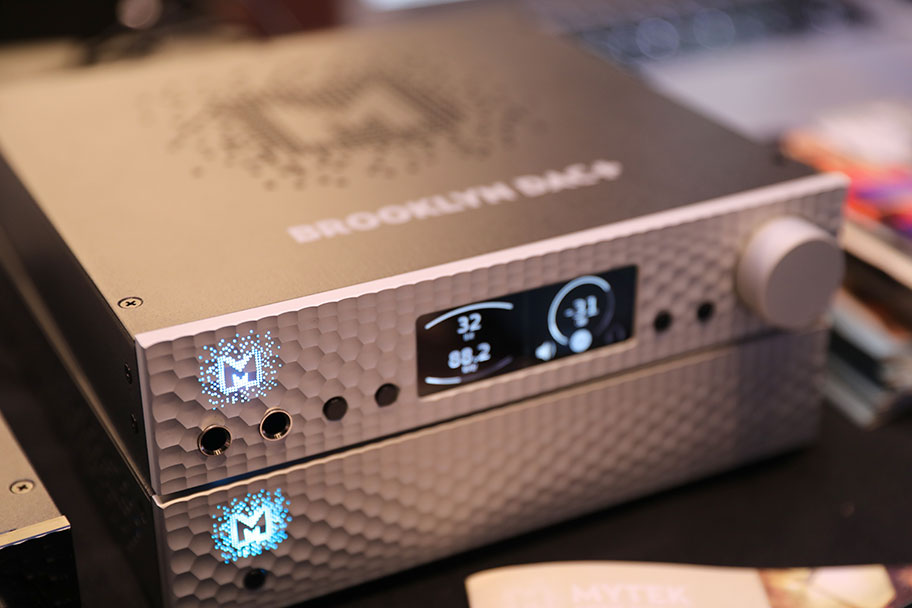
We also think it's worth considering the Mytek Brooklyn DAC+. If the ADI-2 DAC is a German supercar, built in their hermetically-sealed factory outside Haimhausen - yes, we had to Google it - then the Brooklyn DAC+ is American muscle car, knocked together in a New York garage. It's a rough and ready DAC with a hugely attractive design, and like the ADI-2 DAC, it has a screen on the front to help you navigate menus. While the screen itself isn't as good as the one on the ADI-2 DAC, it's far easier to navigate, with a much more sensible layout, and a basic set of context-sensitive controls. Ultimately, we still prefer the ADI-2 DAC, which once again offers better sound quality, but the $2,195 Brooklyn DAC+ is still an excellent alternative.
RME offer a huge range of products, many of which we'd actually recommend the average person steer clear of. They are far more geared towards a professional studio environment, rather than a listening one. However, if you want more complexity and outputs to play with, then we recommend the RME ADI-2 Pro FS. It costs $1,999, versus $1,099 for the ADI-2 DAC, and gives you a range of analog inputs and outputs to tinker with. While navigation and overall sound quality are mostly the same, this is clearly the solution if you know you're going to be doing some recording in the future, or simply want more flexibility. For most of us, the less expensive ADI-2 DAC will be more than enough.